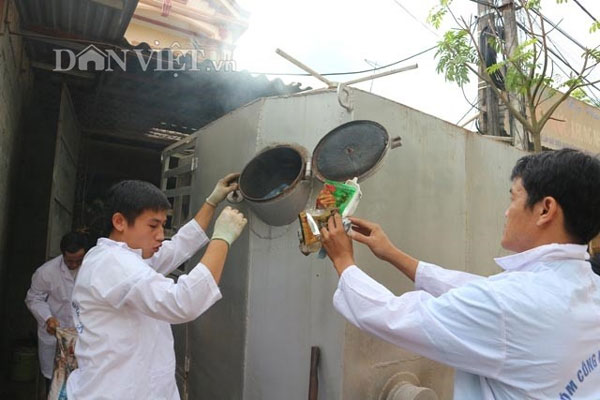
Hoping to turn an idea into reality, six people with the same drive and passion devoted their time to finding the optimal solution to a daily rubbish problem.
 |
| Tao Nguyen Giap (left) and a group member put rubbish into the machine for burning. |
Hoping to turn an idea into reality, six people with the same drive and passion devoted their time to finding the optimal solution to a daily rubbish problem.
Their story begins in 2012. Do Quoc Thai, 50, from Hanoi, and five other people set up a group named Kim Cuong Viet (Viet Diamond) to develop a waste treatment machine.
After years of research, they invented a technique for non-burial waste disposal.
This technology applies the principle of pyrolysis, or heat used to create pressure in waste treatment. The machine the group built can treat inorganic and organic waste such as children’s diapers or medical waste.
“The advantage of the technology is it can produce gas, crude oil and microbiological fertilizers after the burning process, and helps take metals and alloys for reuse in industry. It also costs less than modern technology,” said Thai, the head of the research team.
The machine costs about VND800 million (US$35,500), he said.
The machine is made of steel with a weight of 3.2 tonnes and can handle 20 tonnes of waste a day. It includes two incinerators and a gas treatment system to ensure environmental safety.
The team has tested the machine on garbage at the Nam Son landfill in Hanoi’s Soc Son District and the results of analysis of crude oil and ash samples meet scientific standards.
Tao Nguyen Giap, 29, of northern Vinh Phuc Province, said brick, stone, iron, glass or porcelain would be sorted before burning to take the alloys and metals for sale to recycling plants. Organic and inorganic waste would be treated to produce crude oil, gas and organic fertilizer.
Inorganic waste would be put into a machine to cut the material into small pieces and remove water before incineration.
"After burning at a temperature of thousands of degrees Celsius, the waste will turn into ash, which is then used as a material for further burning that can create crude oil, gas and potassium. Potassium will be used as a catalyst for organic waste composting within 48 hours to produce organic fertilizer for agricultural production,” Giap told Nong Thon Ngay Nay (Countryside Today) newspaper.
After a lot of hard work and effort, the group achieved their first success by introducing their waste treatment technology at Uy No Commune of Hanoi’s Dong Anh District.
This year, the team has introduced their invention in northern Ninh Binh Province’s Gia Vien and Nho Quan districts, Tan Huong Commune in northern Thai Nguyen Province and Hanoi’s Dong Anh and Soc Son Districts, receiving high praise from locals.
They said that Thai had devoted significant time and money to the group’s research. He personally loaned hundreds of million dong to the project.
Other members sold valuable items from their homes to pay for research, Thai said.
“In addition to studying the incinerator, each person had his own job, even living hundreds of kilometres away from Hanoi but often meeting to discuss their project. We all have to work hard but are very happy when we can create a useful product for the community,” said Thai.
“The machine is suitable for waste treatment in communes with reasonable investment and high economic efficiency,” he added.
The group was trying to complete documents to submit to the Ha Noi Science and Technology Department for recognition and also find more collaborators to invest in and further develop the technology, Thai said.
Besides this research, the group is drafting the design of a medical waste treatment machine and a smart utility pole.
(Source: VNS)





